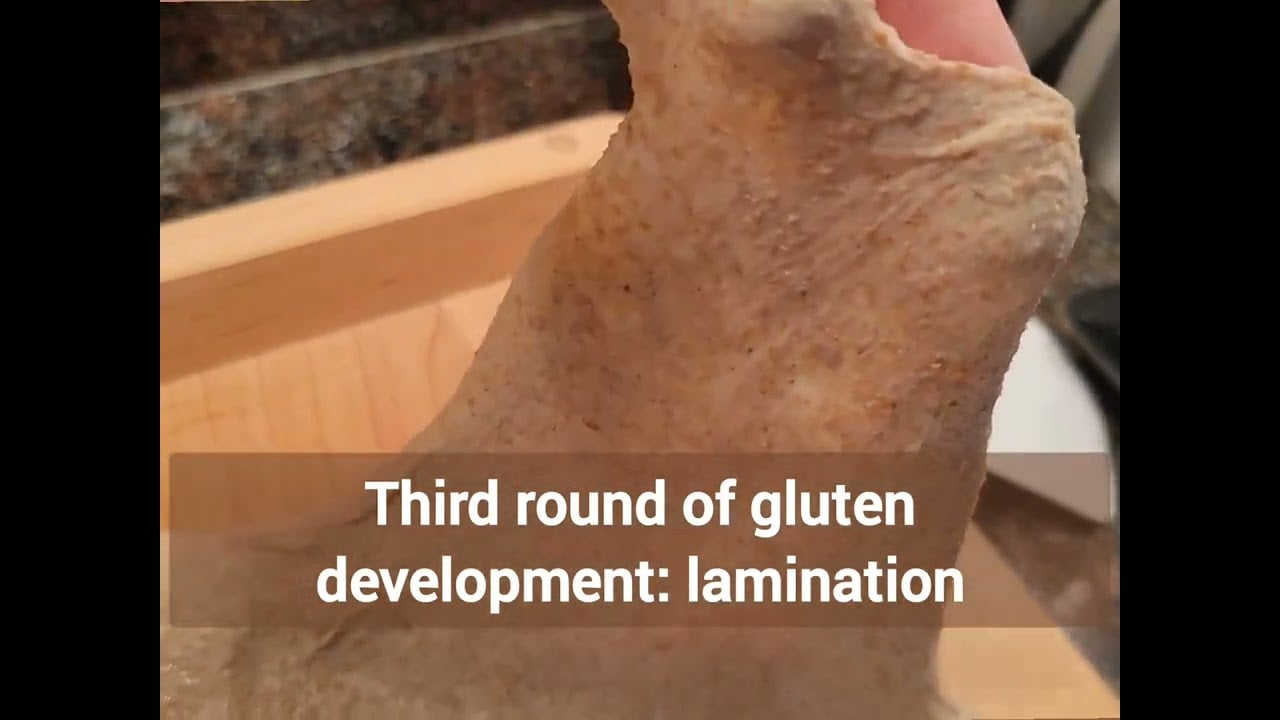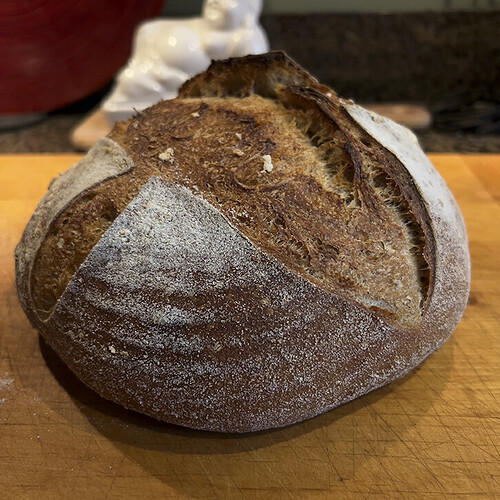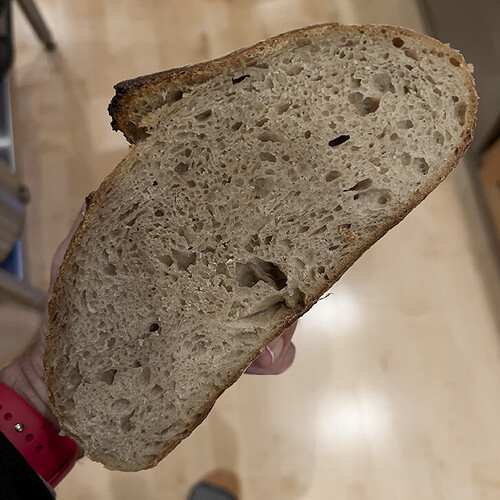In 10 months of baking sourdoughs my doughs have never passed the vaunted windowpane test. I’ve tried countless recipe variations, different flours, starters at different point is their maturation, different levels of hydrations, stretch-and-folds numbering in the 7-8 times range. And still my dough always tears when I test its resilience. What is the secret?
How does your bread turn out?
If it’s nicely aerated with good oven spring, then I wouldn’t worry about the windowpane test.
Well, it comes out: delicious, nicely chewy, sour on the low side, not the greatest oven spring, and a crumb that my wife and I argue about whether it’s open enough. I don’t feel it is. She thinks I’m obsessing over such details because of YouTube overexposure. ![]() No, I mean as far as sourdough qua sourdough (I love being able to use “qua” outside of a Scrabble game!) it’s been a great addition to our gastronomic life. We could go through a loaf in 24 hrs if we let ourselves. I’m just…I dunno…suffering from YouTube overexposure.
No, I mean as far as sourdough qua sourdough (I love being able to use “qua” outside of a Scrabble game!) it’s been a great addition to our gastronomic life. We could go through a loaf in 24 hrs if we let ourselves. I’m just…I dunno…suffering from YouTube overexposure.
I’m glad you had the opportunity to use the word qua ![]()
I’m thinking you may be overworking the dough with 7 to 8 rounds of stretching and folding. That could be causing it to become more fragile.
I’d try a windowpane after the third or fourth round of gluten development and then just let the dough sit.
Also if your dough is mostly or all whole grain flour, I wouldn’t expect a particularly transparent windowpane.
This blog post on gluten development might be of interest to you:
And the slurry test in this blog post might help you test your flours.
Thx for the links. I’ll def check 'em out.
Well, that’s interesting what you said about overworking the dough with 7 or 8 s/fs. I thought working the dough–however long–is what develops the gluten. No?
Just made a batch yesterday and DID check for window pane after 3 and it tore immediately. I never even got to a point where I could lie to myself, “oh yeah, that’s pretty translucent.”
As for my dough, it’s almost always 4 bread flour : 1 rye. Been using King Arthur 12.7% protein flour. This loaf I baked today was with a new flour: Cairnspring Mills Espresso, 13-14% protein and their rye @ 70% hydration. Had a great spring coming out of the fridge after 18 hours. Easily popped out of the banetton, while maintaining its height. But, as always happens to me, running the lame across the top immediately deflates it and it never recovers fully in the bake (20 mins covered dutch oven, 15 mins uncovered). Very tight crumb.
I dunno. I’ve tried shorter bulk proof, longer bulk proof. I’ve gone with 65% hydration, 75% hydration. Used 1:1:1 starter, 1:2:2 starter, 1:5:5, 1:50:50. I don’t know if it means anything but I have yet to have a dough that wasn’t unmanageable to some degree in terms of stickiness; even at 65% hyd.
Well, I’ve gone on. Thanks for listening. At least the stuff is delicious and makes an excellent piece of toast.
I’m sure I’ve spoken it once or twice in my life, but I’m pretty sure I’ve never written the word “qua” (until now).
…Anyway, I doubt that 20% rye should prohibit you from pulling a windowpane, but rye is notoriously sticky and hard to handle.
Here’s a suggestion for a quick sanity check. Do your normal recipe and process but use 100% bread flour (no rye) with hydration at 70% and let’s see what happens.
BTW, just like you can under or over proof your dough, you can definitely under or overwork it and end up with unoptimized gluten structure. In bread it’s all about finding balance.
Your description of what you see and what happens when you take the dough out of the fridge immediately said “overproofed” to me.
Here’s some YouTube for you ![]() My whole grain dough from today.
My whole grain dough from today.
It’s delicate but not very sticky.
Rye is wonderful, but I agree with @homebreadbaker that it’s sticky. If there’s enough rye in a dough (>75%) I don’t even touch the dough but to mix and shape.
I also think your dough deflating and not springing in the oven could be overproofing.
Hoo boy…once again, questions answered engender new questions. Don’t know where to begin. Let me preface by explaining that my 9 month sourdough journey was largely guided by a Danish dude named Sune, AKA Foodgeek. His many YT vids pertain to food-making, however the vast majority concern his experimentations with the sourdough process (https://youtube.com/c/Foodgeek). As such, some of his/my methods don’t always coincide with other approaches I’ve seen.
One thing I’m running up against is what y’all are calling over-proofing. Semantics is a bothersome thing: “Proofing” What is proofing? Is it just another way to say “bulk fermentation”? Is it the same thing as “fermentation”? Let me outline my understanding of the process:
—1: mix all ingredients, or
—1a: mix autolyse prior to adding salt and starter
—2: let rest 30 mins-1 hr
—3: begin stretch and folds, theoretically three times separated by 30 minutes.
—4: (and this is where he diverges from others) dough is place in a bulk proofing container for the first rise. Now, I keep reading people measuring their proofing in multiple hours; in some cases as long as 8, 9 hours. Sune has us proof by volume. He doesn’t go by time but his proofing container allows him to monitor the rise. His process calls for a 25-30% rise in volume being optimal (there’s a video!). WHen I do this and place the container in the “cold” oven with just its light of for warmth, my dough reaches that 25-30% in less than an hour! So I’m really getting turned around by terminology. Is the hours long “proofing” I’m reading about mean fermentation in the fridge?
—Remove from container and shape…rest…then final shape and into the banetton.
—Place into airtight bag and into the fridge for 12-? Hours @ ca.38ºF
—Bake with Dutch oven like most recipes call for.
Now, the rye issue. This Sune guy, unless he’s making something specific, his recipes invariably use that 4:1 flour to rye ratio I’d mentioned previously. His hydration is never below 75 but his handling is nearly mess-free (boy, those vids you provided me here, talk about no mess. That dough looks unnatural) But yeah, rye is not an issue. His high oven spring and wide-open crumb are consistent from loaf to loaf. And no, no deflation.
Well, I should stop here. Again, I’ve gone on. Apologies for any forum guidelines I might be violating here. But if y’all respond to anything here, please school me on where in my process “over-proofing” is happening because I’m not following.
Thx for your attention
ab
I don’t think you’ve violated any forum guidelines. There are many breaducators out there and it’s interesting to learn from any and all!
Let me start by apologizing in advance if I confuse any of the details of your baking experience with another currently ongoing forum thread
Whether you go with a fermentolyse or an autolyse, it sounds like your bulk fermentation is at most 2-3 hours. That to me seems very risky for underfermention (unless it’s 85F in your kitchen thru the stretch and folds, not just the lit oven, and you’re using like 50% starter in your baker’s percentages). A 25-30% expansion of the dough seems small to me too, if we ignore the clock. But as you noted, it works well for Sune.
So you might ask him what he’s using for bread flour. Some bread flours, including Breadtopia’s have 13.5% protein, or higher. Also is his rye sifted/light or full of bran and germ? What are his dough and ambient temps?
You’re correct that the terminology is a little bit wonky. In my vocab, the entire rising process is “fermentation,” and shaping can happen anywhere along the way (with varied results). But I and others do often throw “overproofed” out there to mean too much cumulative fermentation (first and second rise), so I agree it’s confusing.
Some things to think about:
If shaping happens very early in the total fermentation, then the shape is likely to release its tension by the time you bake.
If shaping happens very late in the total fermentation, the dough will not refill with air very much before you bake.
But there is a wide margin of acceptable outcomes. I tend to shape late at 75% expansion, while @benito (whose crumbs are amazing) I believe shapes more at 50% expansion. Correct me if I’m wrong, Benny.
If you shape a dough that’s under fermented (imo less than 40% expansion) but let it proof for a long time, you’ll often get upward trajectory diagonal bubbles in the crumb. In contrast, if the final proof were pretty short/all cold, you’d get a dense gummy crumb possibly with “mouse holes.” An underfermented dough going into the refrigerator is going to be really dormant compared to one that is farther along the fermentation curve when it gets cold.
If you shape a dough that’s over fermented but then shorten the final proof, you’ll get a flatter loaf with relatively even but small holes. Lots of flavor too. But if this final proof were pretty long or very hot, you get a denser and flatter loaf due to utter collapse of the structure.
I hope some of this info helps. You might check out the other thread I linked to above.
Edited to add: I really don’t think there are rules of thumb about dough expansion before shaping. I know I threw minimum 40% out there, but often I hit 100% too. The amount of whole grain flour, enrichment like eggs and butter, goals for the final product – this all impacts how the dough is going to behave.
Yes Melissa you are correct. Depending on the bread, I will often end bulk fermentation with a aliquot jar measured rise of only 40-50%. In fact for baguettes I stop even earlier at around only 20% rise for pre-shaping and then aim to bake at only 35% rise. But I think baguettes are an unusual case. For other breads shaped like batards 40-50% rise for shaping and depending on the strength of the dough, bake anywhere between 70-100% rise with the lower range for weaker doughs.
For my skills, I find it challenging to shape a batard when the dough is fermented past 50% rise and end up degassing it too much. So I shape a bit earlier and let the dough complete fermentation shaped.
Thanks for explaining your strategies, Benny. I agree that baguettes (and pizza) are different animals because of how fast the heat penetrates through the dough during baking. I still ferment both pretty far though LOL
Thanks for your thorough reply. Unfortunately, I’m still confused re terminology.
Bulk fermentation: that’s essentially the first rise–in the container–after all the stretch/folds, yes? But I don’t get where you say “…it sounds like your bulk fermentation is at most 2-3 hours.” Confused where that number comes from. As I’d said my dough is “done” rising after like 45 minutes.
And if the dough rises, say, 30% in 45 minutes, and, say, an hour passes from subsequent pre-shape/rest/final shaping and into the banetton; followed by 18 hrs in the very cold fridge, where in that process is the overproofing that y’all have posited is likely my issue? It almost sounds like you don’t advocate long fridge time?
BTW, my guy Sune sources his flour from local (Demark) mills. Tho he has mentioned, in a positive light, flours with American availability: Montana, Sir Lancelot (A King Arthur flour I believe) as well as mentioning that many of his viewers use King Arthur.
If you feel like it, and have 20 minuted to kill (don’t we all!) here’s a link to his “master recipe.” https://www.bitlylinks.com/8CVW7O7RS It’s basically my approach. If you watch it you can tell me where the over-proofing happens.
ps–starter percentage was mentioned above. I normally use 20% and my starter is good. The batch I used for my last loaf quadrupled after feeding.
Thx!
ab
I calculate the bulk fermentation from the moment the starter hits the dough. Based on your scoring and deflation, overproofing/fermentation sounded like the issue. But based on your short process, underproofing/fermentation seemed like a possibility. Hard to say ![]()
I don’t understand how it can be overproofed when it takes me less than an hour to rise 50%, yet I read of others taking 4-8 hours for their dough to proof. Also, 12-18 hours retarding seems to be the norm, which is what I do, so…
I find this article helpful for understanding sourdough fermentation. I probably should have linked you to it earlier.
I agree that your process does not scream of overproofing risk.
Moreover with how you describe the texture of the dough and the speed of the rising, I’m almost thinking you may have an atypical strain of bacteria or yeast that is proteolytic.
Do you have any photos of your bread? Inside and out, to see the outcome?
Wow. I’m impressed. You get into the sourdough weeds! I do have photos (r u kidding? Do I have photos?!?!) Can’t get to them this minute but I just wanted to reply with my astonishment at the broaching of the possibility of proteolytic strains of bacteria! (Whatever that is) I’ll attach pix under separate cover when I get a chance.
But before that, let me report that I tried a new recipe yesterday (my same starter, if that makes a proteolytic difference) and have experienced something new. It’s currently retarding but will be baking it in a few hours. It was 75% hydration but only marginally sticky and very manageable. The final shape came about like in the online vids and I was finally able to “stitch” the seam upon placing in the banetton. These are the alterations from previous bakes:
—10% whole wheat instead of 20% rye
—a levain which I hadn’t used since my first loaf
—only 15g starter (in levain) where I normally use 100g
So we’ll see. I’m trying not to be overly optimistic (!) but I’m looking forward to te outcome.
Thx
ab
I do love sourdough science; the weeds are quite beautiful and nourishing haha
I hope your recent bake came out well. I’m glad the dough was manageable. Do update when you have a chance.
So…I dunno. I’m just not hitting the sweet spot.
Yesterday’s bake and the oven rise looked, eh, okay. It didn’t deflate when I scored it which gave me hope. The scored revealed much bubbling within. But when cut open it had a pretty tight crumb. It’s really delicious, tho, and the sour is tasty. Finally getting some ear-action.
I guess I’ll continue with the levain strategy; see if that’s what made the difference. Perhaps higher ratio of whole wheat
Here are the pix:
That is a nice ear and lovely crumb. I understand that you want a more open interior though, and I think you’re on the right track with experimenting.
“Lovely” is it? Well, alrighty then. If YOU think so, I’ll take it! (you mean I shouldn’t be aiming for a crumb so open that most of the butter falls thru to the plate? ![]() )
)
I’ll let you know if I have any other breakthroughs. (I actually think I over proofed it in bulk. Got caught up in a “Succession” episode and it rose about 75% so I’ll try for less)
Thanks!


